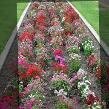| Adaptive Nonrigid Registration |
| Image Registration and Fusion Systems |
Often the images to be registered are large and have local geometric differences, requiring a smart registration method that can learn local
geometric differences between the images and adapt to the local differences. This software achieves adaptive registration in a coarse-to-fine
fashion, initially registering the images at a coarse resolution using a homography, and then gradually increasing the resolution and adapting
to more local geometric differences between the images, and finally using the information gained in this hierarchical approach to register the
entire images using a collection of homographies, each describing the local geometric difference between corresponding neighborhoods in
the images. The homographies are combined using rational weights to create a smooth transformation function that can establish
point--by-point correspondence between the images.
The software is suitable for registering large images taken at different times, at different distances, and/or different viewing angles of a 3-D
scene. The software is ideal for registering frames in an aerial video of a terrain or urban scene. The software is also suitable for registering
biomedical images in the same modality.
The software is designed to be particularly fast on very large images that contain a few to several million pixels. Image registration examples
by this software are given below. The homographies calculated at each resolution and the entire adaptive transformation function for the
registration of images can be saved and reused later, registering the same images.
Fig. 1 shows registration of images taken by an airborne camera at large off-nadir viewing angles. The software provides various tools to
visually evaluate the registration result as demonstrated in Fig. 1.
Additional registration results by this software are provided in Fig. 2.
For more information about this adaptive image registration software, please contact .
geometric differences between the images and adapt to the local differences. This software achieves adaptive registration in a coarse-to-fine
fashion, initially registering the images at a coarse resolution using a homography, and then gradually increasing the resolution and adapting
to more local geometric differences between the images, and finally using the information gained in this hierarchical approach to register the
entire images using a collection of homographies, each describing the local geometric difference between corresponding neighborhoods in
the images. The homographies are combined using rational weights to create a smooth transformation function that can establish
point--by-point correspondence between the images.
The software is suitable for registering large images taken at different times, at different distances, and/or different viewing angles of a 3-D
scene. The software is ideal for registering frames in an aerial video of a terrain or urban scene. The software is also suitable for registering
biomedical images in the same modality.
The software is designed to be particularly fast on very large images that contain a few to several million pixels. Image registration examples
by this software are given below. The homographies calculated at each resolution and the entire adaptive transformation function for the
registration of images can be saved and reused later, registering the same images.
Fig. 1 shows registration of images taken by an airborne camera at large off-nadir viewing angles. The software provides various tools to
visually evaluate the registration result as demonstrated in Fig. 1.
Additional registration results by this software are provided in Fig. 2.
For more information about this adaptive image registration software, please contact .
(a)
(b)
(c)
(d)
(e)
Fig. 1. (a), (b) Two aerial views of a city. (c) Resampling of image (b) to spatially align with image (a). (d) overlaying of images (a) and (c). (e)
Checkerboard overlaying of registered images, facilitating visual evaluation of the registration result. (f) The software allows zooming in an
area and viewing the registration accuracy from up close.(g), (h) The software also provides an interactive means of evaluating the
registration quality by viewing images (a) and (c) side by side along different rows and columns interactively with the motion of the mouse.
Checkerboard overlaying of registered images, facilitating visual evaluation of the registration result. (f) The software allows zooming in an
area and viewing the registration accuracy from up close.(g), (h) The software also provides an interactive means of evaluating the
registration quality by viewing images (a) and (c) side by side along different rows and columns interactively with the motion of the mouse.
To purchase a license for this image registration software, follow this link =>

For questions, please contact:




(f)


(g)
(h)











(a)
(b)
(d)
(c)
(g)
(e)
(f)
(i)
(h)
Fig. 2. Further registration results by this software. To view the registration results in their original scales, click at the images. For telling apart
the images better, the resampled image is slightly lowered in intensity in these images. Images (b) and (c) are courtesy of NASA.
the images better, the resampled image is slightly lowered in intensity in these images. Images (b) and (c) are courtesy of NASA.